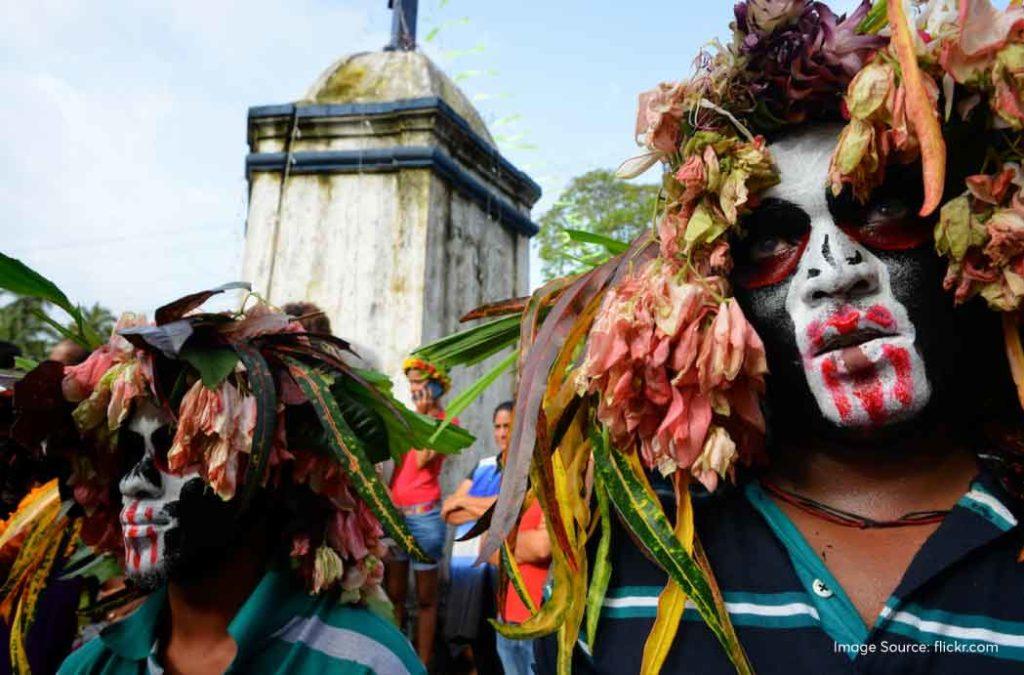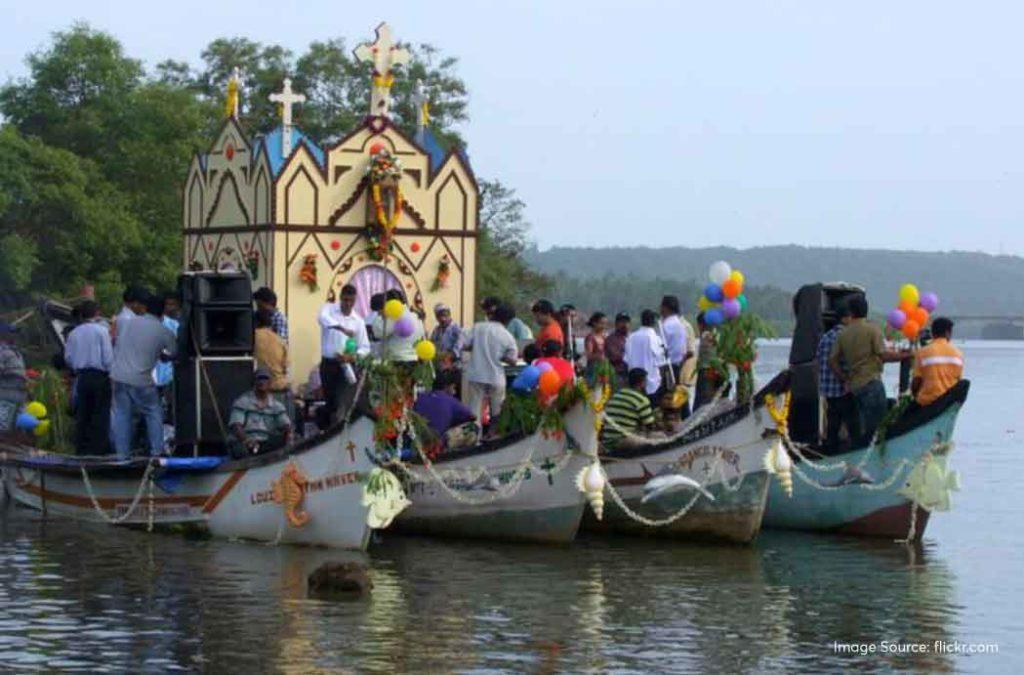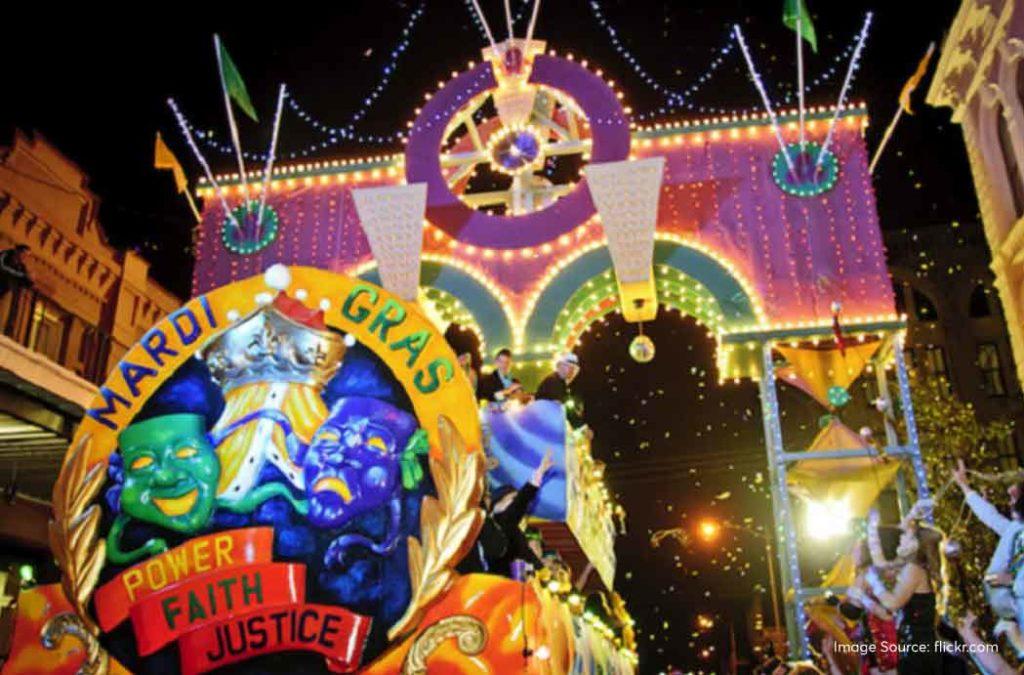The Sao Joao Festival of Goa is a yearly catholic religious event that brings in the much-awaited celebration of culture and tradition. This is when the locals deck up in new clothes, decorate their houses with flowers and also don accessories like angel wings and flower wreaths.

But, what is the Sao Joao festival really about? Let’s dig deeper and learn about its historical significance, dates, location, the unique Goan traditions during this time and the modern celebrations across Goa.
History of the Sao Joao Festival
The Sao Joao Festival in Goa is celebrated on the birth anniversary of St. John, the Baptist. The festival is closely related to the Feast of the Annunciation which happens three months before Sao Joao.
At the Annunciation, Angel Gabriel told Mary, the mother of Jesus, that she would be having a baby boy in the future. He also told Mary that her sister, Elizabeth, was already in her sixth month of pregnancy and would deliver a baby boy soon.

Mary went to Elizabeth to greet her dear sister after she heard the good news from Gabriel. When the baby in Elizabeth’s womb heard Mary’s greeting, he ‘leapt’ with excitement. Within a few months, Elizabeth gave birth to St. John. The leap is a significant event that marks the happiness of St. John after knowing that Jesus would soon grace the Earth.
St. John was a wild child and preferred to stay close to nature. He would eat locusts and wild honey. He preferred to wear clothes made from camel’s hair. It was St John who baptised Jesus at the Jordan River when the Lord was 30 years old. Celebrating Sao Joao is one of the oldest practices of the Christian church and has been prevalent since 506 AD.
Dates and location
The Sao Joao Festival is celebrated on the 24th of June every year. It happens three months after the Feast of the Annunciation and six months before the birth of Christ on the 25th of December.

The festival is celebrated more vibrantly in North Goa than in South Goa. You will hardly find people gathering to commemorate the day of St. John’s birth in the southern part of the state. The Siolim Village of North Goa is the major hub where a lot of celebrations happen and people take to the streets, sing religious hymns and share a drink or two while they are at it. Also, the Baga, Calangute, Anjuna and Assagao regions have impressive events that locals and tourists can attend.
Unique Goan traditions of the Sao Joao Festival
The Sao Joao Festival is an important catholic event of reverence across the globe but the celebrations in Goa are a tad bit different. The locals add more energy and charm to the common rituals of sharing food and drinks.
Jumping into water bodies
After the prayers at the Church, the men dive into the nearby wells, ponds and water bodies. This signifies the ‘leap’ that St. John took when he heard of Jesus’s birth and also the baptism of Jesus at the River Jordan. Also, the end of June is the monsoon season in Goa and the weather is perfect for participating in some fun diving and drenching. This is a practice that is native to Goa and is not seen anywhere else in the world.
Not many know the Sao Joao festival’s water body jumping tradition is not mere ‘fun and games’. The men pray for good monsoon showers and the well-being of their family and community before they dive in.
The Sangodds
Sangodds are boats or floating rafts that are decorated elaborately during the Sao Joao Festival. They are made from scratch! The talented artists use the locally sourced bamboo, wood and banana trunks to make the boats and then decorate them beautifully with ribbons, flowers, coconut fronds, colourful fabrics and some would also make figurines and cartoon characters to place them on the boat. Making of the Sangodds creates a sense of community among the people. Locals come together and put in efforts to make the most beautiful Sangodd and these are then displayed on the Goan backwaters.

They also make themed Sangodds that represent the life story of St, John, the Baptist, Jesus Christ, Mary and Elizabeth and also different local folklore and social issues. Different local families, fishermen, farmers, schools and cultural clubs enrol to make their custom Sangodds during the Sao Joao Festival. When the boats or rafts sail, the team who made it would ride it and sing traditional songs and also sway a little to show their happiness and put up a good show. Some would also go ahead and play musical instruments.
Some places in Siolim also have competitions to create some healthy rivalry and reward those who make the most unique and spectacular-looking Sangodds of the season.
Floral headgears
You will see a lot of people wearing floral wreaths on the day of the Sao Joao Festival. These are headgear that are made from fresh flowers and leaves. The locals refer to them as ‘Kopels’. The Kopels symbolise the beauty of nature and the fertility of the Goan land during the monsoon showers. People also believe that putting them on praying to the Almighty will bring better yield to the state.
It also has a lot to do with St. John and his lifestyle. If you remember, we mentioned that he liked to dwell in the wilderness and preferred to wear camel hair over normal textile fabrics. That is why, the Kopels also represent wearing a part of nature like St. John used to do.
Before the festival, the locals sit together to make the Kopels and it is a fun activity to be a part of. These days, tourists who visit during the festivals also join the locals to make Kopels.
The blessing of fruits
Jackfruit, mangoes and pineapples are the seasonal fruits that are available in abundance during the season. These fruits are collected from the local market or directly from the trees and distributed among the communities after they are blessed by a priest at the local churches. It is a way in which people share nature’s gifts, equally and fairly. Also, they believe the fruits to be the blessings of the monsoon season and it is frowned upon if someone discards or wastes these fruits.
It’s always fun to be in Goa! You can probably make a 4-day itinerary and explore the best of North and South Goa on your next trip.
Celebrations in Goa during the festival
The celebrations in North Goa start from the previous day when people gather to set up wood for the bonfires and also sit down to make kopels. Families spend quality time with each other and tourists get an opportunity to understand a side of Goa that they otherwise do not get to see.

On the day of the festival, people wake up in the morning and dress up in colourful clothing, something that is bright and attractive. They go to the church to offer their prayers and gather on the streets for the processions. These are usually groups of people walking on the street, singing religious songs, playing musical instruments and also sipping on some beer while they are at it.
The men would head straight to wells, ponds, rivers or other water bodies to jump in and commemorate the baptism of Jesus.
Food and drinks
The locals share the seasonal fruits with each other and tourists also get a bagful of them if they are celebrating Sao Joao Festival with the locals. There are public feasts where you can gather and have a meal together. Fenny, the traditional drink of Goa, is distributed among the people and they enjoy a few beers together as well.

These are some of the traditional dishes you will find on the day –
1 – Sorpotel – Pork offal or liver is used to make a spicy and tangy dish that is sautéd in vinegar, tamarind and local spices.
2 – Sannas – Sweet rice cakes that are made from fermented rice and coconut gratings.
3 – Chicken Xacuti – Usually served along with Sannas, this is a chicken curry made with spices, coconut and loads of poppy seeds.
4 – Pork Vindaloo – A pork curry made from sautéd garlic, ginger and spices. The chicken is initially marinated in vinegar. It is a Portuguese dish that is very popular in Goa.
5 – Bebinca – A multilayered milk made with coconut milk, eggs, sugar and flour.
6 – Dodol – A toffee-like sweet that is made from coconut milk, jaggery and rice flour.
7 – Patoleo – Rice cakes that are filled with jaggery and coconut gratings and then steamed in turmeric leaves.
Dance and music
Apart from the casual dance and music that the locals and tourists indulge in, there are traditional dance forms and musical displays that happen at the Sao Joao Festival. Here are a few of them –
1 – Fugdi – Fugdi is a traditional dance that is usually performed by the women. They form two circles, one moving clockwise and the other moving anti-clockwise. They perform synchronised steps while clapping hands and spinning around occasionally.
2 – Dhalo – This dance form is usually performed within the backyards of the Goan houses. The family members gather in a circle and perform the dance that has elaborate footwork and occasional clapping.
3 – Mando – This is a beautiful dance form that blends Goa’s traditional culture with the Portuguese influence in the region. Mando involves people dancing to the tunes of mandolin, guitar and violin.

The local schools, educational institutions and community clubs have their own Sao Joao celebrations where they come together as a community to perform on a stage, sing, dance, play games, have a potluck, pray together and also share the blessed seasonal fruits.
As we mentioned earlier, the festivities are more prominent in North Goa than in South Goa. So, we suggest that you find hotels in Goa that are closer to the northern belt to get the best out of the day.
Modern celebrations of the Sao Joao festival across the world
Goa is not the only place where the Sao Joao Festival is celebrated. It is a part of the culture of other nations where people from the Goan diaspora live. For instance, London, Canada and the Middle Eastern countries see Sao Joao Festivities on the 24th of June. The Goan communities and groups come together to spend time together on the day and also keep the ‘jumping into the well’ culture intact. Well, any nearby water body works, isn’t it? They also wear colourful Kopels and walk together in processions while praising the Lord and narrating the musical stories of St. John, the Baptist.

There is a Portuguese tradition that is not followed in Goa but is part of the festival celebrations in other countries. People use a small and soft plastic hammer to hit each other in the head. This is believed to drive away evil spirits and harmful energies.
FAQs
1 – When is the Sao Joao Festival celebrated in Goa?
A – The Sao Joao Festival is celebrated on the 24th of June during the monsoon season every year.
2 – Why is the Sao Joao Festival celebrated?
A – The Sao Joao Festival commemorates the birthday or the birth anniversary of St. John, the cousin of Jesus and the priest who baptised the Lord at the River Jordan.
3 – What are the colourful boats during the Sao Joao Festival?
A – The colourful boats or rafts are called Sangodds. These are made using wood, sticks, and bamboo and are decorated beautifully. They sail over the Goan backwaters and rivers during the Sao Joao Festival.
4 – Can tourists be a part of the Sao Joao Festival?
A – Yes, tourists can be part of Sao Joao Festival celebrations in Goa. People come here to take part in the festivities and see a side of Goa that goes beyond beaches and parties.
Have you been to the Sao Joao Festival in Goa or want to be a part of it soon? Tell us all about it in the comments section below.























